Input interpretation
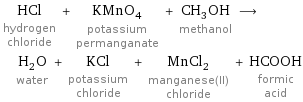
HCl hydrogen chloride + KMnO_4 potassium permanganate + CH_3OH methanol ⟶ H_2O water + KCl potassium chloride + MnCl_2 manganese(II) chloride + HCOOH formic acid
Balanced equation
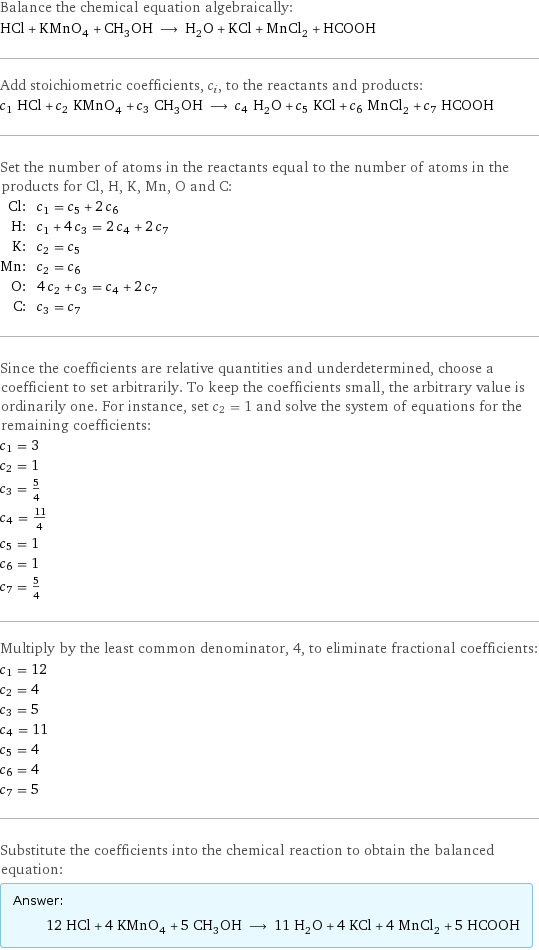
Balance the chemical equation algebraically: HCl + KMnO_4 + CH_3OH ⟶ H_2O + KCl + MnCl_2 + HCOOH Add stoichiometric coefficients, c_i, to the reactants and products: c_1 HCl + c_2 KMnO_4 + c_3 CH_3OH ⟶ c_4 H_2O + c_5 KCl + c_6 MnCl_2 + c_7 HCOOH Set the number of atoms in the reactants equal to the number of atoms in the products for Cl, H, K, Mn, O and C: Cl: | c_1 = c_5 + 2 c_6 H: | c_1 + 4 c_3 = 2 c_4 + 2 c_7 K: | c_2 = c_5 Mn: | c_2 = c_6 O: | 4 c_2 + c_3 = c_4 + 2 c_7 C: | c_3 = c_7 Since the coefficients are relative quantities and underdetermined, choose a coefficient to set arbitrarily. To keep the coefficients small, the arbitrary value is ordinarily one. For instance, set c_2 = 1 and solve the system of equations for the remaining coefficients: c_1 = 3 c_2 = 1 c_3 = 5/4 c_4 = 11/4 c_5 = 1 c_6 = 1 c_7 = 5/4 Multiply by the least common denominator, 4, to eliminate fractional coefficients: c_1 = 12 c_2 = 4 c_3 = 5 c_4 = 11 c_5 = 4 c_6 = 4 c_7 = 5 Substitute the coefficients into the chemical reaction to obtain the balanced equation: Answer: | | 12 HCl + 4 KMnO_4 + 5 CH_3OH ⟶ 11 H_2O + 4 KCl + 4 MnCl_2 + 5 HCOOH
Structures
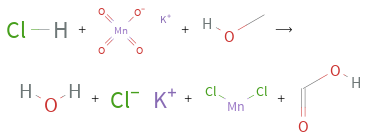
+ + ⟶ + + +
Names

hydrogen chloride + potassium permanganate + methanol ⟶ water + potassium chloride + manganese(II) chloride + formic acid
Reaction thermodynamics
Gibbs free energy
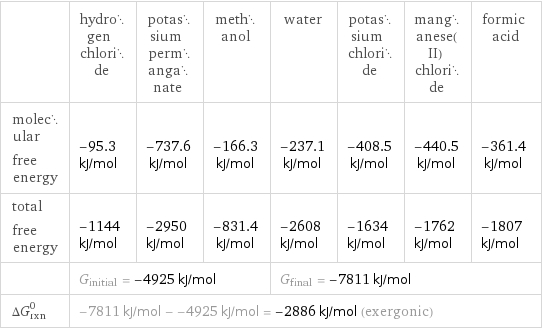
| hydrogen chloride | potassium permanganate | methanol | water | potassium chloride | manganese(II) chloride | formic acid molecular free energy | -95.3 kJ/mol | -737.6 kJ/mol | -166.3 kJ/mol | -237.1 kJ/mol | -408.5 kJ/mol | -440.5 kJ/mol | -361.4 kJ/mol total free energy | -1144 kJ/mol | -2950 kJ/mol | -831.4 kJ/mol | -2608 kJ/mol | -1634 kJ/mol | -1762 kJ/mol | -1807 kJ/mol | G_initial = -4925 kJ/mol | | | G_final = -7811 kJ/mol | | | ΔG_rxn^0 | -7811 kJ/mol - -4925 kJ/mol = -2886 kJ/mol (exergonic) | | | | | |
Equilibrium constant
![Construct the equilibrium constant, K, expression for: HCl + KMnO_4 + CH_3OH ⟶ H_2O + KCl + MnCl_2 + HCOOH Plan: • Balance the chemical equation. • Determine the stoichiometric numbers. • Assemble the activity expression for each chemical species. • Use the activity expressions to build the equilibrium constant expression. Write the balanced chemical equation: 12 HCl + 4 KMnO_4 + 5 CH_3OH ⟶ 11 H_2O + 4 KCl + 4 MnCl_2 + 5 HCOOH Assign stoichiometric numbers, ν_i, using the stoichiometric coefficients, c_i, from the balanced chemical equation in the following manner: ν_i = -c_i for reactants and ν_i = c_i for products: chemical species | c_i | ν_i HCl | 12 | -12 KMnO_4 | 4 | -4 CH_3OH | 5 | -5 H_2O | 11 | 11 KCl | 4 | 4 MnCl_2 | 4 | 4 HCOOH | 5 | 5 Assemble the activity expressions accounting for the state of matter and ν_i: chemical species | c_i | ν_i | activity expression HCl | 12 | -12 | ([HCl])^(-12) KMnO_4 | 4 | -4 | ([KMnO4])^(-4) CH_3OH | 5 | -5 | ([CH3OH])^(-5) H_2O | 11 | 11 | ([H2O])^11 KCl | 4 | 4 | ([KCl])^4 MnCl_2 | 4 | 4 | ([MnCl2])^4 HCOOH | 5 | 5 | ([HCOOH])^5 The equilibrium constant symbol in the concentration basis is: K_c Mulitply the activity expressions to arrive at the K_c expression: Answer: | | K_c = ([HCl])^(-12) ([KMnO4])^(-4) ([CH3OH])^(-5) ([H2O])^11 ([KCl])^4 ([MnCl2])^4 ([HCOOH])^5 = (([H2O])^11 ([KCl])^4 ([MnCl2])^4 ([HCOOH])^5)/(([HCl])^12 ([KMnO4])^4 ([CH3OH])^5)](../image_source/ce9593facc42e1f462a96fac648b46e5.png)
Construct the equilibrium constant, K, expression for: HCl + KMnO_4 + CH_3OH ⟶ H_2O + KCl + MnCl_2 + HCOOH Plan: • Balance the chemical equation. • Determine the stoichiometric numbers. • Assemble the activity expression for each chemical species. • Use the activity expressions to build the equilibrium constant expression. Write the balanced chemical equation: 12 HCl + 4 KMnO_4 + 5 CH_3OH ⟶ 11 H_2O + 4 KCl + 4 MnCl_2 + 5 HCOOH Assign stoichiometric numbers, ν_i, using the stoichiometric coefficients, c_i, from the balanced chemical equation in the following manner: ν_i = -c_i for reactants and ν_i = c_i for products: chemical species | c_i | ν_i HCl | 12 | -12 KMnO_4 | 4 | -4 CH_3OH | 5 | -5 H_2O | 11 | 11 KCl | 4 | 4 MnCl_2 | 4 | 4 HCOOH | 5 | 5 Assemble the activity expressions accounting for the state of matter and ν_i: chemical species | c_i | ν_i | activity expression HCl | 12 | -12 | ([HCl])^(-12) KMnO_4 | 4 | -4 | ([KMnO4])^(-4) CH_3OH | 5 | -5 | ([CH3OH])^(-5) H_2O | 11 | 11 | ([H2O])^11 KCl | 4 | 4 | ([KCl])^4 MnCl_2 | 4 | 4 | ([MnCl2])^4 HCOOH | 5 | 5 | ([HCOOH])^5 The equilibrium constant symbol in the concentration basis is: K_c Mulitply the activity expressions to arrive at the K_c expression: Answer: | | K_c = ([HCl])^(-12) ([KMnO4])^(-4) ([CH3OH])^(-5) ([H2O])^11 ([KCl])^4 ([MnCl2])^4 ([HCOOH])^5 = (([H2O])^11 ([KCl])^4 ([MnCl2])^4 ([HCOOH])^5)/(([HCl])^12 ([KMnO4])^4 ([CH3OH])^5)
Rate of reaction
![Construct the rate of reaction expression for: HCl + KMnO_4 + CH_3OH ⟶ H_2O + KCl + MnCl_2 + HCOOH Plan: • Balance the chemical equation. • Determine the stoichiometric numbers. • Assemble the rate term for each chemical species. • Write the rate of reaction expression. Write the balanced chemical equation: 12 HCl + 4 KMnO_4 + 5 CH_3OH ⟶ 11 H_2O + 4 KCl + 4 MnCl_2 + 5 HCOOH Assign stoichiometric numbers, ν_i, using the stoichiometric coefficients, c_i, from the balanced chemical equation in the following manner: ν_i = -c_i for reactants and ν_i = c_i for products: chemical species | c_i | ν_i HCl | 12 | -12 KMnO_4 | 4 | -4 CH_3OH | 5 | -5 H_2O | 11 | 11 KCl | 4 | 4 MnCl_2 | 4 | 4 HCOOH | 5 | 5 The rate term for each chemical species, B_i, is 1/ν_i(Δ[B_i])/(Δt) where [B_i] is the amount concentration and t is time: chemical species | c_i | ν_i | rate term HCl | 12 | -12 | -1/12 (Δ[HCl])/(Δt) KMnO_4 | 4 | -4 | -1/4 (Δ[KMnO4])/(Δt) CH_3OH | 5 | -5 | -1/5 (Δ[CH3OH])/(Δt) H_2O | 11 | 11 | 1/11 (Δ[H2O])/(Δt) KCl | 4 | 4 | 1/4 (Δ[KCl])/(Δt) MnCl_2 | 4 | 4 | 1/4 (Δ[MnCl2])/(Δt) HCOOH | 5 | 5 | 1/5 (Δ[HCOOH])/(Δt) (for infinitesimal rate of change, replace Δ with d) Set the rate terms equal to each other to arrive at the rate expression: Answer: | | rate = -1/12 (Δ[HCl])/(Δt) = -1/4 (Δ[KMnO4])/(Δt) = -1/5 (Δ[CH3OH])/(Δt) = 1/11 (Δ[H2O])/(Δt) = 1/4 (Δ[KCl])/(Δt) = 1/4 (Δ[MnCl2])/(Δt) = 1/5 (Δ[HCOOH])/(Δt) (assuming constant volume and no accumulation of intermediates or side products)](../image_source/54c86297210a56c621ee18fff37783a5.png)
Construct the rate of reaction expression for: HCl + KMnO_4 + CH_3OH ⟶ H_2O + KCl + MnCl_2 + HCOOH Plan: • Balance the chemical equation. • Determine the stoichiometric numbers. • Assemble the rate term for each chemical species. • Write the rate of reaction expression. Write the balanced chemical equation: 12 HCl + 4 KMnO_4 + 5 CH_3OH ⟶ 11 H_2O + 4 KCl + 4 MnCl_2 + 5 HCOOH Assign stoichiometric numbers, ν_i, using the stoichiometric coefficients, c_i, from the balanced chemical equation in the following manner: ν_i = -c_i for reactants and ν_i = c_i for products: chemical species | c_i | ν_i HCl | 12 | -12 KMnO_4 | 4 | -4 CH_3OH | 5 | -5 H_2O | 11 | 11 KCl | 4 | 4 MnCl_2 | 4 | 4 HCOOH | 5 | 5 The rate term for each chemical species, B_i, is 1/ν_i(Δ[B_i])/(Δt) where [B_i] is the amount concentration and t is time: chemical species | c_i | ν_i | rate term HCl | 12 | -12 | -1/12 (Δ[HCl])/(Δt) KMnO_4 | 4 | -4 | -1/4 (Δ[KMnO4])/(Δt) CH_3OH | 5 | -5 | -1/5 (Δ[CH3OH])/(Δt) H_2O | 11 | 11 | 1/11 (Δ[H2O])/(Δt) KCl | 4 | 4 | 1/4 (Δ[KCl])/(Δt) MnCl_2 | 4 | 4 | 1/4 (Δ[MnCl2])/(Δt) HCOOH | 5 | 5 | 1/5 (Δ[HCOOH])/(Δt) (for infinitesimal rate of change, replace Δ with d) Set the rate terms equal to each other to arrive at the rate expression: Answer: | | rate = -1/12 (Δ[HCl])/(Δt) = -1/4 (Δ[KMnO4])/(Δt) = -1/5 (Δ[CH3OH])/(Δt) = 1/11 (Δ[H2O])/(Δt) = 1/4 (Δ[KCl])/(Δt) = 1/4 (Δ[MnCl2])/(Δt) = 1/5 (Δ[HCOOH])/(Δt) (assuming constant volume and no accumulation of intermediates or side products)
Chemical names and formulas
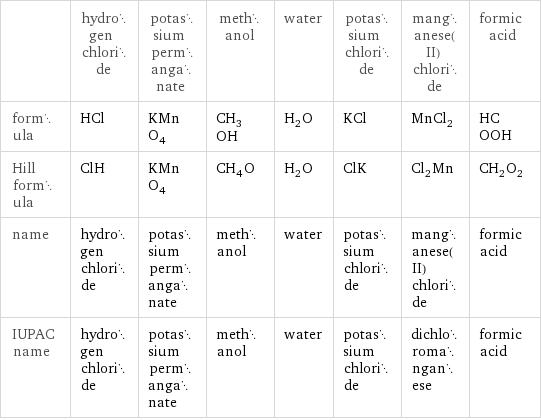
| hydrogen chloride | potassium permanganate | methanol | water | potassium chloride | manganese(II) chloride | formic acid formula | HCl | KMnO_4 | CH_3OH | H_2O | KCl | MnCl_2 | HCOOH Hill formula | ClH | KMnO_4 | CH_4O | H_2O | ClK | Cl_2Mn | CH_2O_2 name | hydrogen chloride | potassium permanganate | methanol | water | potassium chloride | manganese(II) chloride | formic acid IUPAC name | hydrogen chloride | potassium permanganate | methanol | water | potassium chloride | dichloromanganese | formic acid